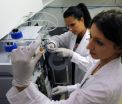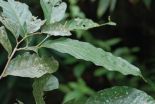(Press-News.org) How strongly do two dissolved analytes react with each other? Such information is of paramount importance not only in chemistry and molecular biology, but also in medicine or pharmacy, where it is used, i.a., to determine optimal drug doses. A method developed in the Institute of Physical Chemistry of the Polish Academy of Sciences in Warsaw will allow for determining diffusion coefficients of analytes in fluids and equilibrium constants of reactions – quickly, at low cost, and most importantly: universally.
In many medical therapies, a prerequisite for efficient treatment is to maintain appropriate drug concentration in patient's blood. Soon, the selection of optimal doses can be assisted by simple measurement devices that make use of a method for measuring equilibrium constants of analytes in fluids developed in the Institute of Physical Chemistry of the Polish Academy of Sciences (IPC PAS) in Warsaw. Only a few millilitres of blood would allow, while you wait, for precise matching of a drug dose with specific patient's body features.
The research on diffusion has been for years carried out at the IPC PAS. The research is based on the phenomena occurring during flow of a liquid, similar to those observed in rivers. In a river bed water flows faster in the bed's central part than at the banks, and when vortices appear in the current, water masses are mixed more effectively. A similar physics helped researchers from the IPC PAS in development of a simple method for determining diffusion coefficients.
The crucial component of the apparatus used in the IPC PAS is a very long (30 m) and very thin polymer tube – a capillary. Inside the capillary there flows a carrier liquid: water at room temperature and pH value corresponding to that of human blood. The capillary is tightly coiled, and the flowing water moves at high velocity. The combination of the two factors makes the flow in the capillary not fully homogeneous, and results in generation of little vortices.
When a small amount of an analyte is injected into a stream of a carrier liquid flowing in the capillary, it spreads out quickly into a long streak. The researchers from the IPC PAS looked at the analyte concentration in the carrier liquid at the outlet from the capillary. In line with the expectations, the highest concentration was in the centre of the capillary, while the lowest one was found at the walls. The plot of the distribution of the analyte concentration along the capillary diameter was bell-shaped, and so it had the shape of the famous Gauss curve.
"In spite of a high flow rate and the presence of vortices, we were able to relate the variations in the distribution of the analyte concentration in the cross-section at the end of the capillary – i.e., simply speaking, the width of the Gauss bell – with the flow rate, the viscosity of the carrier liquid, the capillary curvature, and the diffusion coefficient of the analyte. The first three factors are known, which means that in practice it's enough to measure the width of the 'bell' in order to determine the diffusion coefficient", explains Anna Lewandrowska, a doctoral student at the IPC PAS.
"Interestingly, the results of our measurements were inconsistent with current theoretical models, constructed on the basis of approximated solutions of the famous Navier-Stokes equations", comments Prof. Robert Holyst (IPC PAS). "These equations, let us remind, describe the movement of fluids, and at present their solutions are known for the simplest flows only. So, we had to determine experimentally our own formula describing our measurement system and the phenomena occurring therein".
In earlier versions of the apparatus the measurements were carried out at low flow rates, only 0.05 millilitre per minute. The analysis of a single analyte required 40 minutes, yielding for some macromolecules results with errors reaching up to 30%. Now the flow speed is twenty times higher. The time needed to determine the diffusion coefficient was reduced down to three minutes, and the accuracy of measurements increased more than five times.
The shortening of analysis time is important from the medical practitioner's point of view. The determination of a drug dose optimal for a specific patient requires not one, but three measurements. "First, we have to introduce drug molecules into the capillary and to determine the rate of their diffusion. Then we measure the diffusion of protein, with which the drug is to bind, for instance, albumin. In the third measurement we inject both the drug and the protein, with which the drug interacts, into the capillary filled with the same protein. Only the comparison of the results allows to find how efficiently the drug will bind to the protein in patient's blood", explains Aldona Majcher, a doctoral student at the IPC PAS.
The patent-pending method for determining of the diffusion coefficient in fluids is fast, versatile, and simple. It does not require any expensive and complicated measurement equipment, and so it has a chance to get popularised and end up in many hospitals and health centres, as well as chemical and biological laboratories. The experiments in the IPC PAS have shown that the method has proven in measurements with salts, amino acids, peptides, proteins und drugs.
INFORMATION:
The research was supported by grants from the Polish National Science Centre and the Foundation for Polish Science.
This press release was prepared thanks to the NOBLESSE grant under the activity "Research potential" of the 7th Framework Programme of the European Union.
The Institute of Physical Chemistry of the Polish Academy of Sciences was established in 1955 as one of the first chemical institutes of the PAS. The Institute's scientific profile is strongly related to the newest global trends in the development of physical chemistry and chemical physics. Scientific research is conducted in nine scientific departments. CHEMIPAN R&D Laboratories, operating as part of the Institute, implement, produce and commercialise specialist chemicals to be used, in particular, in agriculture and pharmaceutical industry. The Institute publishes approximately 200 original research papers annually.
Capillaries will measure diffusion and help in more efficient medical treatment
2014-02-12
ELSE PRESS RELEASES FROM THIS DATE:
Genetic find might lead to cattle that are more resistant to TB
2014-02-12
Scientists have identified genetic traits in cattle that might allow farmers to breed livestock with increased resistance to bovine tuberculosis (TB).
The study, which compared the genetic code of TB-infected animals with that of disease-free cattle, could help to impact on a disease that leads to major economic losses worldwide.
The research, led by the University of Edinburgh's Roslin Institute, has identified a number of genetic signatures associated with TB resistance in the cows that remained unaffected.
The study builds on previous research by The Roslin Institute, ...
Mindfulness meditation may improve decision making
2014-02-12
One 15-minute focused-breathing meditation may help people make smarter choices, according to new research from researchers at INSEAD and The Wharton School. The findings are published in the February issue of Psychological Science, a journal of the Association for Psychological Science.
People have trouble cutting their losses: They hold on to losing stocks too long, they stay in bad relationships, and they continue to eat large restaurant meals even when they're full. This behavior, often described as "throwing good money after bad," is driven by what behavioral scientists ...
Scientists discover a new pathway for fear deep within the brain
2014-02-12
Cold Spring Harbor, NY – Fear is primal. In the wild, it serves as a protective mechanism, allowing animals to avoid predators or other perceived threats. For humans, fear is much more complex. A normal amount keeps us safe from danger. But in extreme cases, like post-traumatic stress disorder (PTSD), too much fear can prevent people from living healthy, productive lives. Researchers are actively working to understand how the brain translates fear into action. Today, scientists at Cold Spring Harbor Laboratory (CSHL) announce the discovery of a new neural circuit in the ...
Poaching threatens savannah ecosystems
2014-02-12
White rhinoceros may be extinct in twenty years with the current poaching rates. The loss of this megaherbivore is in itself a tragedy, but it may also have tremendous effects on the ecosystems they now live in.
The white rhino (Ceratotherium simum), and other megaherbivores, are key drivers of ecosystem functioning because they´re not controlled by predation.
A new study by Joris Cromsigt and Mariska te Beest, published in Journal of Ecology, highlights the role of the white rhino in the savannah ecosystems.
Earlier empirical studies on the ecosystem impact of megaherbivores ...
Exercise targets cellular powerhouses to improve heart function
2014-02-12
Whether lifting weights in a gym or just walking around the block, exercise has many benefits, such as helping people lose weight and build stronger muscles. Some studies suggest that it may reduce the risk of developing cancer and other diseases. Researchers now report in ACS' Journal of Proteome Research that moderate, long-term physical activity appears to improve cardiovascular health in mice by targeting the heart cells' powerhouses — the mitochondria.
Eduard Sabidó, Francisco Amado and colleagues explain that despite the well-documented benefits of exercise, the ...
How stellar death can lead to twin celestial jets
2014-02-12
Astronomers know that while large stars can end their lives as violently cataclysmic supernovae, smaller stars end up as planetary nebulae – colorful, glowing clouds of dust and gas. In recent decades these nebulae, once thought to be mostly spherical, have been observed to often emit powerful, bipolar jets of gas and dust. But how do spherical stars evolve to produce highly aspherical planetary nebulae?
In a theoretical paper published this week in the Monthly Notices of the Royal Astronomical Society, a University of Rochester professor and his undergraduate student ...
GVSU researchers draw link between zebra mussels, risk of algae blooms
2014-02-12
Researchers at Grand Valley State University's Annis Water Resources Institute are learning more about the impact invasive zebra mussels and native aquatic insect larvae have on the risk of algae blooms in two West Michigan lakes. The results of the research will be published in the journal Oikos.
Postdoctoral researcher Geraldine Nogaro and AWRI director Alan Steinman studied the impact that invasive zebra mussels and native chironomid larvae have on nutrient releases in Muskegon Lake and Bear Lake. While studying the mussels, Nogaro and Steinman noted that filter feeding ...
Waste from age-old paper industry becomes new source of solid fuel
2014-02-12
In today's search for renewable energy sources, researchers are turning to the hi-tech, from solar and hydrogen fuel cells, and the very low-tech. The latest example of a low-tech alternative comes from an age-old industry: paper. A new study, appearing in ACS' journal Energy & Fuels, reveals a sustainable way to turn the huge amounts of waste from paper production into solid fuel with the added bonus of diverting the sludge from overflowing landfills.
Chinnathan Areeprasert, Peitao Zhao and colleagues note that making paper, from debarking and chipping wood to the final ...
Australian state has higher rate of hypothermia deaths than Sweden
2014-02-12
New research from the University of Adelaide shows that the state of South Australia has a higher rate of deaths from extreme cold compared with the northern European nation of Sweden.
The study, by a team from the University's School of Medical Sciences, analyzed forensic cases of hypothermia deaths from 2006-2011 in both South Australia and Sweden.
The results show that South Australia had a rate of 3.9 deaths for every 100,000 people, compared with Sweden's 3.3 deaths per 100,000. In total, there were 62 fatal cases of hypothermia in South Australia and 296 cases ...
A new species of Oak hidden away in the greenery of Ton Pariwat Wildlife Sanctuary
2014-02-12
An international team of scientists from Xishuangbanna Tropical Botanical Garden (China) and the Forest Herbarium (BKF - Thailand) discovered a new species of Stone Oak in the Ton Pariwat Wildlife Sanctuary in Thailand. This isolated sanctuary is popular for its rich bird- and wildlife such as the Blue-banded Kingfisher and Whitehanded Gibbons, as well for its rare and beautiful flora like Rafflesia's - known to hold some of the largest flowers on earth. The wildlife sanctuary covers a region of low-lying forested mountains and is located in the middle of a fascinating ...




